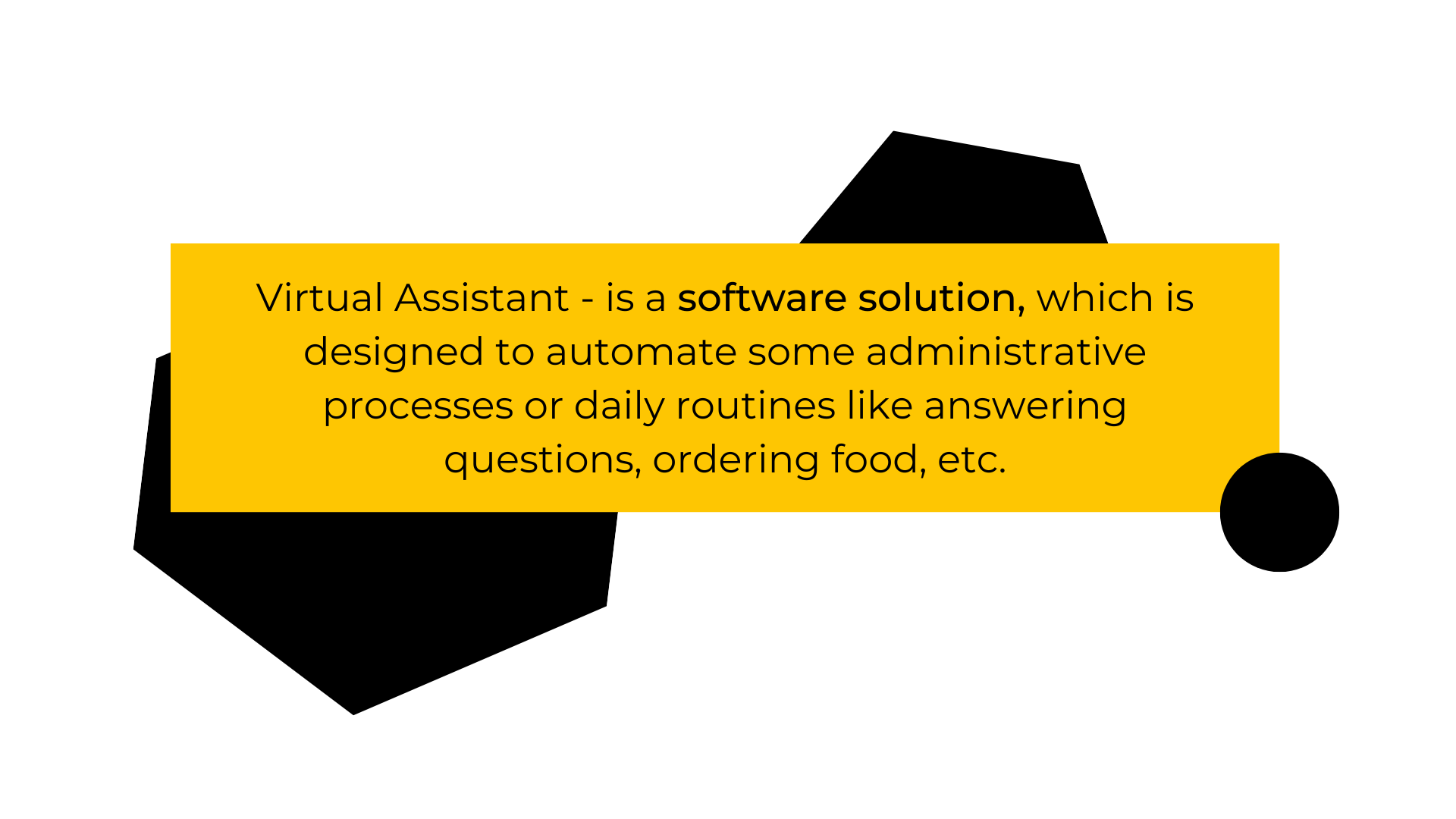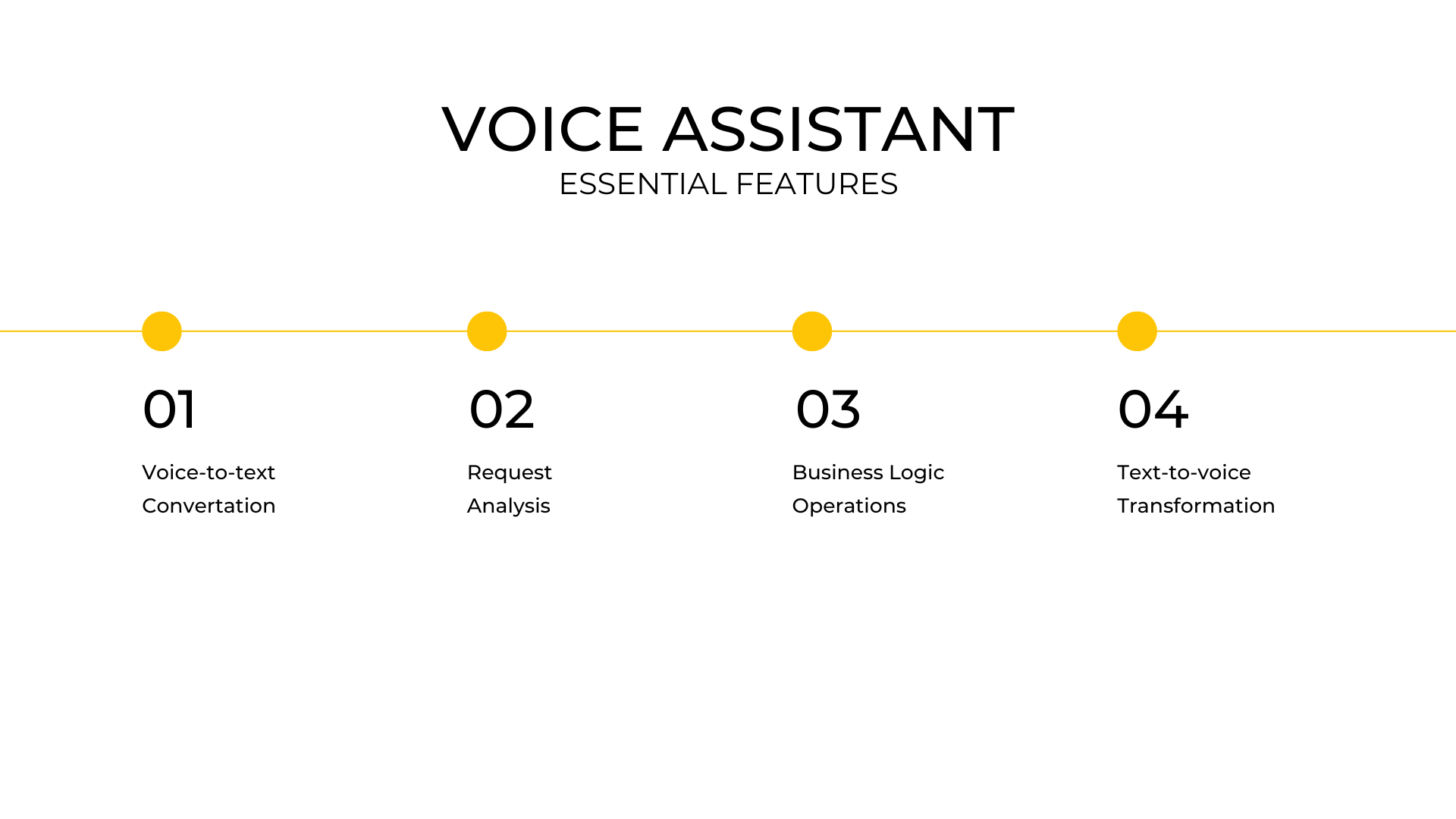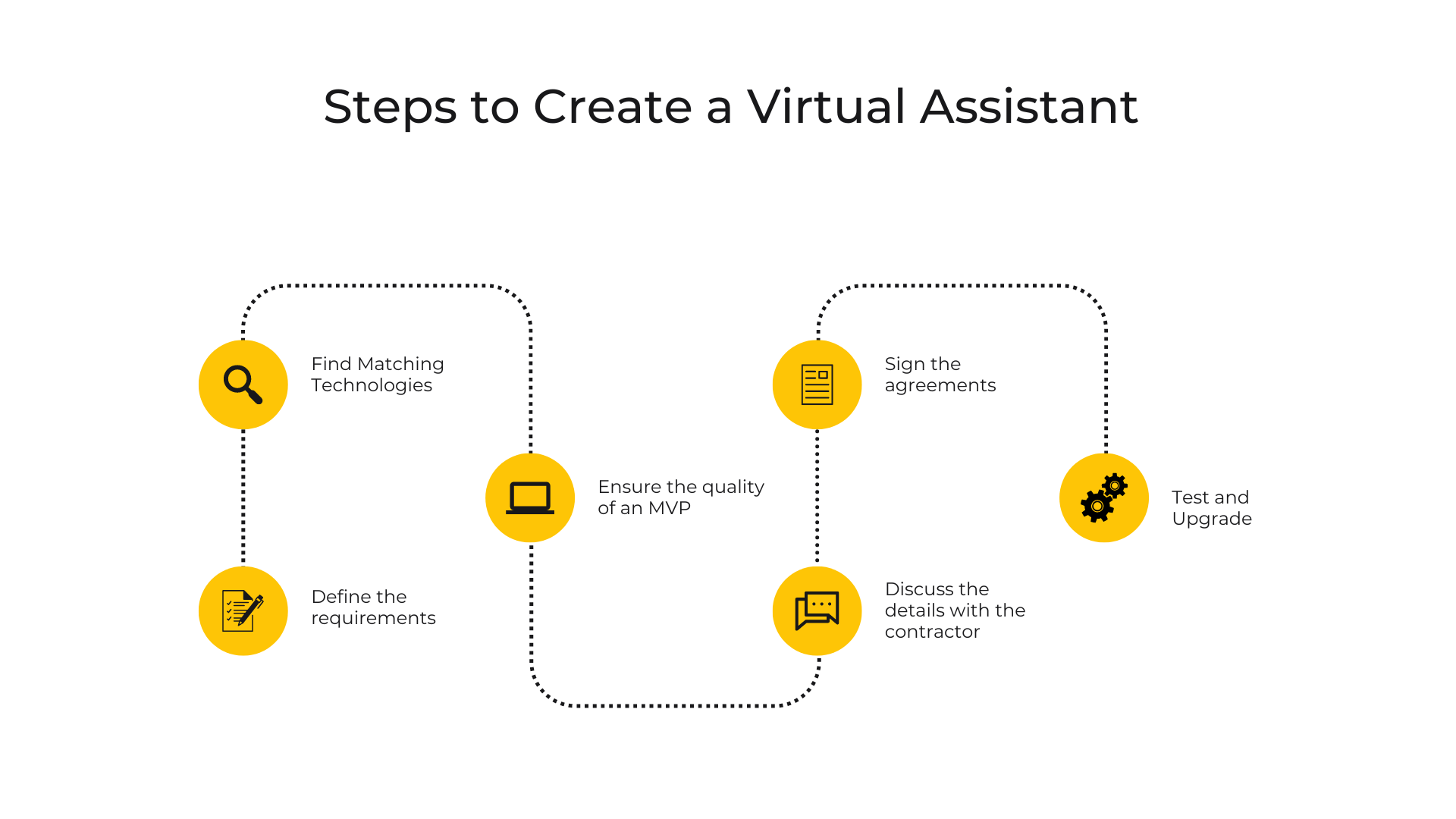How to Create a Virtual Assistant Like Siri
June 22, 2023 • 1116 Views • 17 min read
Tetiana Stoyko
CTO & Co-Founder

Frankly speaking, extra features are definitely worth considering and integrating. Yet, it is also true that they are EXTRA, i.e. should be developed only after the basic version of an app was created and tested correctly. In other words, ensure your MVP startup meets all requirements and performs the best it can.
Why Virtual Assistants Will Prevail?
Obviously, there is a wide range of various possible variations of extended functionality like blockchain-based solutions, Artificial Intelligence implementation, Natural Language Processing chatbots, etc, and the custom digital assistant is just one of them.
Most such extensions are mainly extremely complex and difficult to develop from scratch. For instance, you can try to create your own map service for your delivery application. However, as the experience shows, even such tech giants as Uber are incapable of developing such features off the bat. For now, they are still using Google Maps API, making plans on switching to their own Maps software product in the nearest future.
Thus, instead of spending all the resources on a single feature, it is better to consider choosing a ready-to-use software solution and pay more attention to polishing your product.
Yet, not all additional features are as hard to create, as, let’s say, developing own AI from scratch. One such example is a custom voice assistant. So how to make a virtual assistant and what is it?
Virtual Assistant App Explained
This type of software is actually an extremely popular and spread solution within some industries like banking.
To cut a long story short, virtual assistant is software, designed specifically to automate some routine tasks, making it easier for different employees, and also empowering the overall user experience, allowing them to pay more attention to the customers. To make it even simpler, these are mainly robots, programmed machines, which are performing tasks, they were designed for.

As a matter of fact, there is a large number of various personal assistant apps. For instance, there are traditional chatbots, which exist in the form of text, or you can make your own Siri virtual assistant, that will react to your voice commands.
The potential form and communication methods vary, depending on your imagination and budget. Besides, recently the AI industry, as well as the field of virtual assistants expanded. With the emergence of such AI instruments like ChatGPT, MidJourney, and the rest, it becomes much easier to create your own virtual assistant apps, using these software solutions for your own business purposes. For a better illustration, let’s consider some examples.
How Does Siri Type App Work?
There are two possible answers to this question: a short and a long one.

To make it simple, any voice assistant app, regardless of whether it is Siri, Alexa, or any other, is based on the same scheme:
- Voice-to-text convertation. At this phase, the app gets access to the device’s microphone in order to hear the request. When the request is voiced, the assistant needs to perform speech compression and transform it into text.
- Request Analysis. After the user’s request was transformed into the text format, the application can proceed to find out what is the request, i.e. analyze it.
- Business Logic. This stage means that the already transformed and analyzed request is being operated due to the business logic. In other words, the actual work is being done and the virtual assistant tries to find answers on how to deal with requests and the answer is being formed.
- Text-to-Voice. Eventually, when the report is formed, regardless of the results, the formed answer is transformed from text to voice and in this form is returned to the user.
Summing up all the above, it is possible to assume, that voice assistants are just more advanced chatbots. In fact, most processes are performed in the text format. The only difference - is the interface, which is used by users to communicate with the assistant.
How to Make a Virtual Assistant?

So, the overall working scheme is pretty obvious and simple. Yet, it is not as simple, when it actually comes to the development itself. Therefore, before we actually code one, let’s consider some other important details, which will help us to better understand what you need in order to make your own Siri.
Voice-to-Text Essential Feature
As was mentioned before, most voice assistants basically are advanced chatbots. As a matter of fact, these chatbot-based algorithms are probably the most essential processes for such types of apps. Still, it is also important to ensure the voice recognition technology and transformation stage - the better it is, the more accurate your app will be.
Actually, the text-to-voice phase is less complicated, mainly all the variations of this feature will differ in the quality of the voiced commands and answers.
However, if your entry point, the voice-to-text process, is a low-quality solution, then you might, and most probably will face a lot of issues. Clearly, this interface point defines the overall request formation, definition, and the rest procedures. So, if the recognition is working poorly - the app might not understand the original task, processing a wrong input, or even the mistaken one. So, it is one of the most essential features worth paying attention to.
Siri Type App Development in a Nutshell
Frankly, there are a few ways to do so. First of all, you need to define whether you are considering developing it as a standalone virtual assistant from scratch, which can be simply downloaded to a device and perform various daily tasks, just like Siri for an iPhone, or you are considering developing it as an extra feature for an existing app, just like Chatbots in Logistics.
The choice you make will define all the processes, related to the development: planning, time and resources estimation, choosing tech stack, etc.
Yet, truth be told, the main difference between these two software solutions is the scale of work, and the right to use third-party software.
As we discussed before, nowadays there are lots of different ready-to-use solutions, which can be used under the hood. For instance, such software as Dialogflow, Alexa Skills Set, ChatGPT, and the rest alternatives can be of great use to simplify the development process.
To add some more, in case you are considering developing a standalone virtual assistant app like Siri, you have to understand, that this is a very complex and difficult task, which can be ranged as an enterprise app, i.e. will require a lot of custom made solutions, training, and improvements, as well as possible hardware add-ons.
For example, Amazon’s Alexa is an extremely complicated AI-based model, which took years of development and testing and is accompanied by some hardware, which allows it to use its full potential.
Alternatively, if you are willing to integrate a custom voice assistant technology within your existing application, the task will be less difficult. However, this does not mean, that it will be easy either.
Anyway, regardless of the nature of your future custom voice assistant, there are almost the same development steps to make, which are common for both approaches. To make it even more clear, let’s assume, you are willing to make your own Siri as an extension for an existing application. What should you do then? Unless you are willing to simply integrate a ready-to-use solution such as Siri, Google Assistant, Cortana, or others, then there are a few steps to take.
Step 1: Choose a Tech Stack
Obviously, you need to choose the technologies, you are going to use. What is important, is that there are barely any programming languages or frameworks, which do not support such features. Yet, it is also true, that there are some, which might be a better solution specifically for developing an intelligent assistant.
In our imaginary case, you already have an app, therefore, it is better to use the same programming language, or the one, which can be combined with the one, which is used for an app.
Actually, the most important software solutions to choose, from are not the basic ones, like Python, JavaScript, etc, but the ready-to-use extensions, that enable speech recognition, speech-to-text transformation, processing, and text-to-speech conversation.
Frankly, it is extremely difficult to create custom-made alternatives to such software and APIs, so the simplest way - is to integrate them. Besides, there are countless variations and versions of such software, including free-of-charge open-source libraries, one-time payment extensions, or full-fledged services, based on subscription models. In other words, you won’t be limited to a few options.
To make it simple, you will need to choose:
- Voice-to-text conversion (STT) tool
- Text-to-voice technology (TTS)
- Optionally, a chatbot, which is capable of analyzing text and performing predetermined tasks like GPT-based models. Alternatively, you can develop it on your own, in case you are looking for a more custom voice assistant, that will meet all your requirements.
- And additionally, it is a great idea to look for some extra features for Noise Control, Speech comprehension, voice interfaces, voice biometrics, etc. All of these tools are optional, yet they will help to significantly improve your virtual assistant and upscale it, making it a true custom voice assistant.
Step 2: Design the Business Logic
Clearly, it is an essential step for any type of software or app you are developing. Thus, it is inevitable that you will have to design it in any case.
Yet, it is important to make sure, that your business logic is compatible with the voice assistant feature and won’t cause any issues or struggle with proceeding with different operations, related to it.
Step 3: Develop an IT Infrastructure
Finally, having all the needed instruments, software solutions, and APIs, which meet all your requirements, you can proceed to the development stage.
As a matter of fact, it does not differ a lot from developing other features with the use of third parties. Mainly, your coding will consist of the correct integration of all these instruments, creating the connection between them, setting the parameters and tasks, and testing.
The approximate scheme will look like this:
- Record the command of the user. Mostly, it is better to set a command like “Hey, Virtual Assistant”, or “Ok, Voice Assistant”, which will allow the software to understand when the user is willing to use it.
- Transfer the recorded voice to the Speech-to-text tool, so that it could identify the speech and translate it into text.
- Analyze the text command, which is performed by a chatbot or other similar systems, looking for keywords and commands to be done, i.e. to understand the intent entity and the awaited results.
- Find additional information, related to the user’s request. Obviously, you will need your voice assistant to be connected to a database or the Internet, in order to find the answers to the question and perform some tasks like ordering food, checking the weather outside, booking tickets for a plane, etc.
- Generate a response. After the virtual assistant app performed the foregoing and has an answer, it has to be generated in a text form.
- Eventually, the response from the virtual assistant should be voiced to the user. For this purpose, you will need a text-to-speech convertor, which will basically announce the response.
- Congratulation!
Custom Voice Assistant with Incora
The easiest way to develop your own Siri type app, as well as to integrate a custom voice assistant is to outsource it to niche-experienced development companies. Such companies are proposing dedicated teams of developers, who are familiar with the technologies to use and can upscale your software product by sharing their experience in the field.
For instance, if you choose Incora for developing such a custom solution, you will have simply to contact us and explain your expectations from the idea, then we will make a brief estimation and contact you back for a further discussion with numbers and potential ways how to embody it.
What’s your impression after reading this?
Love it!
3
Valuable
2
Exciting
1
Unsatisfied
2
FAQ
Let us address your doubts and clarify key points from the article for better understanding.
What programming languages and technologies are commonly used to create virtual assistants like Siri?
Popular programming languages for building virtual assistants include Python, Java, and JavaScript. Additionally, technologies such as TensorFlow, PyTorch, or Keras are often used for machine learning and deep learning tasks. Other frameworks and tools like Flask, Django, or Node.js can be employed for web development and API integration.
Can I integrate my virtual assistant like Siri with third-party services?
Yes, you can integrate your virtual assistant with third-party services by leveraging their APIs (Application Programming Interfaces). For example, you can integrate with weather services, news providers, calendar applications, and more. Most popular services provide API documentation and SDKs to facilitate integration.
Can I train my virtual assistant to recognize multiple languages?
Yes, it is possible to train your virtual assistant to understand and respond in multiple languages. You would need to gather training data in each language and modify your natural language understanding and dialogue management components to handle multilingual interactions.
How can I make my virtual assistant understand user context and maintain conversation flow?
Maintaining user context and conversation flow is crucial for a virtual assistant. You can employ techniques like maintaining conversation history, using dialogue state trackers, and implementing context-aware models to ensure the assistant understands and remembers previous interactions.
Is it necessary to have a voice interface for my virtual assistant, or can I use text-based interactions?
While voice interfaces are commonly associated with virtual assistants, it is not mandatory to have one. You can build a text-based virtual assistant that interacts with users through text messages or a graphical user interface (GUI). However, integrating a voice interface can enhance the user experience and make the assistant more intuitive.
Can I deploy my virtual assistant on different platforms, such as smartphones and smart speakers?
Yes, you can deploy your virtual assistant on various platforms. For smartphones, you can develop a mobile app that users can install. For smart speakers or other smart devices, you can create voice-enabled applications or integrate them with existing platforms like Amazon Alexa or Google Assistant.
you may also like
Let’s talk!
This site uses cookies to improve your user experience. Read our Privacy Policy
Accept

Share this article